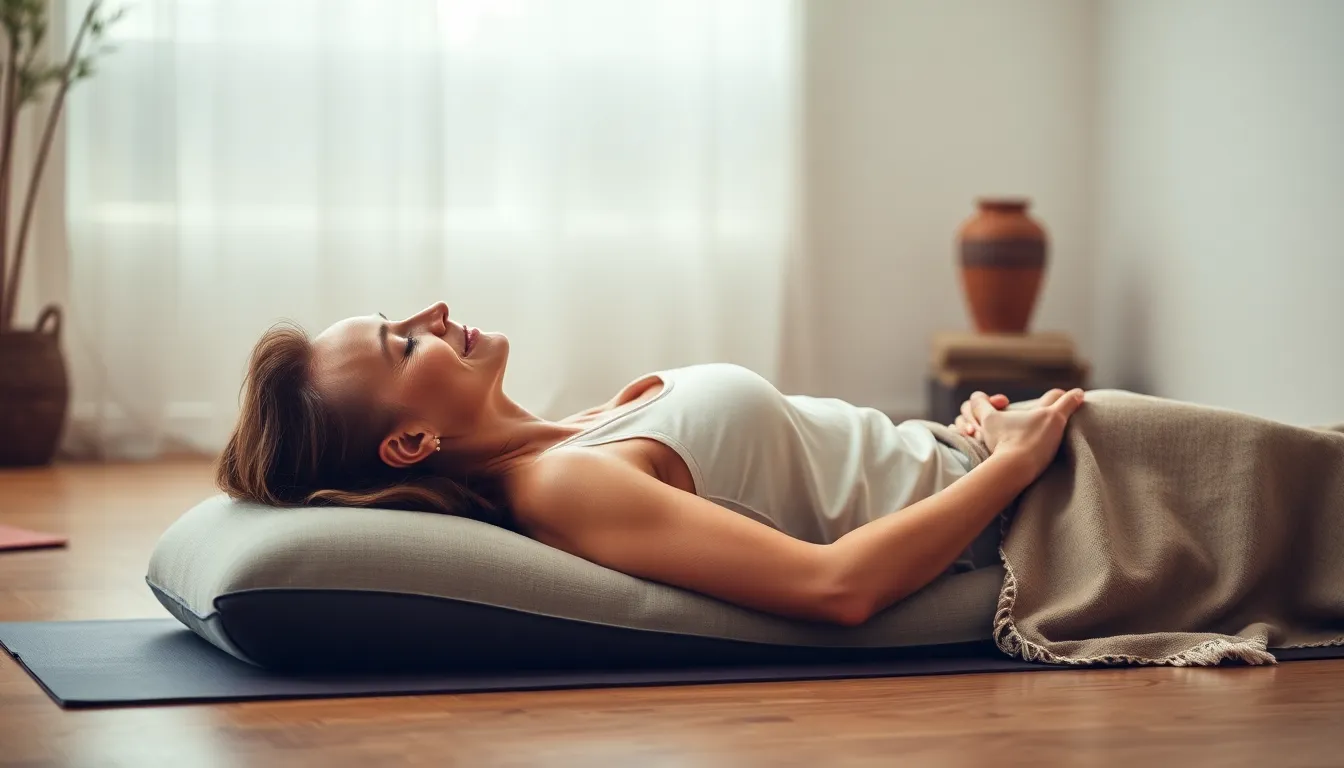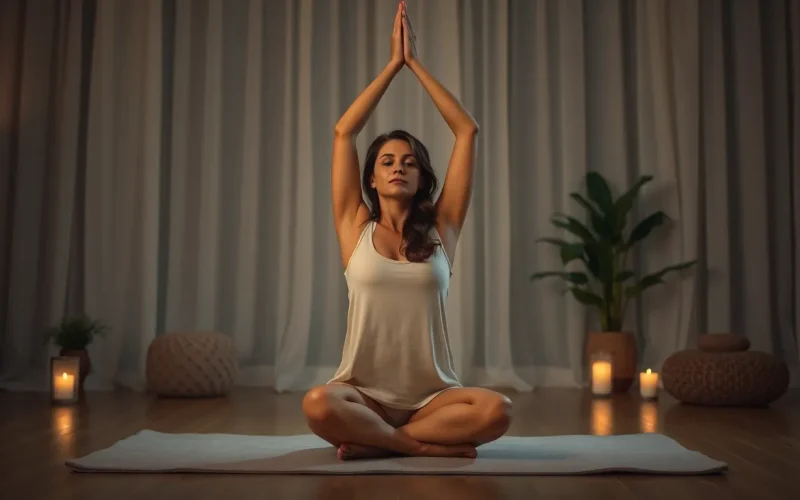Table of Contents
ToggleTossing and turning all night? It’s like a wrestling match with your own pillow, and let’s face it, the pillow is winning. If sleepless nights have become your unwelcome companion, maybe it’s time to roll out the yoga mat instead of counting sheep. Yoga isn’t just for mastering the art of looking graceful while upside down; it can also be your secret weapon for better sleep.
Imagine drifting off to dreamland with the ease of a cat curling up in a sunny spot. With the right poses and breathing techniques, yoga can help calm the mind, relax the body, and send you off to sleep faster than you can say “Namaste.” So, why not trade in those sleepless nights for some soothing stretches? It’s time to embrace the tranquility that yoga offers and reclaim those precious Z’s.
The Connection Between Yoga and Sleep
Yoga significantly contributes to enhancing sleep quality. Practicing yoga techniques can lead to a deeper, more restful sleep.
The Science of Sleep
Sleep cycles consist of different stages, including REM and deep sleep. These stages are crucial for physical recovery and mental health. Research indicates that disruptions in sleep patterns can result in cognitive decline, reduced emotional regulation, and decreased overall wellness. Engaging in regular yoga practice helps regulate hormones related to sleep, such as melatonin and cortisol, by reducing stress levels. Stress management is fundamental for achieving restorative sleep, and yoga excels in promoting relaxation.
How Yoga Influences Sleep Patterns
Yoga impacts sleep patterns by promoting relaxation and reducing anxiety. Incorporating gentle stretches and breathing exercises into a routine can help calm an overactive mind. The practice lowers heart rates and relaxes the muscles, preparing the body for sleep. Specific asanas, like Child’s Pose and Legs-Up-The-Wall, have calming effects that aid in transitioning from a busy day to a peaceful night. Furthermore, mindfulness during yoga cultivates present-moment awareness, leading to enhanced sleep experiences. Through these mechanisms, yoga becomes an effective tool for improving overall sleep quality.
Types of Yoga Beneficial for Sleep

Yoga offers various styles that specifically enhance sleep quality. Each type provides unique techniques that promote relaxation and calmness.
Restorative Yoga
Restorative yoga focuses on deep relaxation through gentle poses held for extended periods. This style encourages the body to release tension while promoting a sense of tranquility. Practitioners often use props such as blankets and bolsters to support the body, allowing for a safe and comfortable experience. By emphasizing slow movements and mindful breathing, restorative yoga calms the nervous system. Studies indicate that this practice reduces stress hormones and encourages more balanced sleep patterns. Regular engagement in restorative sessions can lead to improved sleep quality and enhanced well-being.
Yin Yoga
Yin yoga targets the connective tissues through long-held poses that encourage flexibility and relaxation. Practicing yin yoga often leads to a meditative state, which aids in calming the mind and preparing the body for sleep. Each pose is held for several minutes, allowing for a deep release of physical and mental tension. This style promotes mindfulness and deep breathing, contributing significantly to a peaceful nighttime routine. Research supports the calming effects of yin yoga on sleep, showing it helps regulate sleep cycles and enhances restorative sleep. Integrating yin yoga into a nightly routine can transform challenging sleep patterns into restful nights.
Key Poses for Better Sleep
Incorporating specific yoga poses into a nightly routine can significantly enhance sleep quality. These poses promote relaxation, reduce anxiety, and prepare the body for restful sleep.
Legs-Up-The-Wall Pose
Legs-Up-The-Wall Pose encourages blood circulation while relieving tension in the legs and lower back. Practicing this pose involves lying on the back and extending the legs vertically against a wall. This position calms the nervous system, promoting relaxation and easing stress. Holding the pose for 5 to 10 minutes prepares the body for sleep by enhancing feelings of tranquility. Many find it beneficial for reducing insomnia symptoms, making it an excellent choice for those struggling to unwind.
Child’s Pose
Child’s Pose is renowned for its ability to still the mind and soothe the body. To practice, one kneels on the floor, lays the torso over the thighs, and extends the arms forward. This gentle stretch releases tension in the spine and encourages a sense of safety. Practicing Child’s Pose for 3 to 5 minutes can significantly reduce feelings of anxiety and enhance mental clarity. Many individuals find comfort in returning to this pose, especially after a busy day.
Cat-Cow Stretch
Cat-Cow Stretch effectively promotes spinal flexibility and relaxation. Alternating between arching and rounding the back while on hands and knees encourages the release of tension held in the spine. This fluid movement, typically performed for 5 minutes, synchronizes breath with motion, promoting mindfulness. Engaging in this sequence helps to relieve stress and prepare the body for restful sleep. Practicing Cat-Cow can also enhance overall body awareness, which supports a calming bedtime routine.
Creating a Evening Yoga Routine
Creating an evening yoga routine establishes a peaceful ritual that prepares the body and mind for restful sleep. Incorporating specific practices into the evening can enhance sleep quality and overall relaxation.
Time and Duration
Choose a consistent time for practice each evening, ideally 30 to 60 minutes before sleep. Allocating this time allows the body to unwind, signaling readiness for rest. Sticking to a schedule strengthens the routine, making relaxation easier over time. Start with shorter sessions of 10 to 20 minutes, gradually extending the duration as comfort increases. Evening yoga can fit into a busy schedule and allows individuals to unwind effectively.
Setting the Environment
Setting a calming environment enhances the yoga experience. Dim the lights and ensure the space is quiet to promote relaxation. Use soft music or nature sounds to create a soothing backdrop. Incorporate elements like candles or essential oils to enhance the sensory experience further. Surrounding oneself with comfortable props, such as cushions or mats, provides added support during poses. Creating a dedicated space for yoga encourages a sense of tranquility, making it easier to transition into restful sleep.
Incorporating yoga into a nightly routine can be a game-changer for those struggling with sleep. By practicing specific poses and breathing techniques, individuals can create a calming environment that promotes relaxation and prepares the mind and body for rest.
Styles like restorative and yin yoga offer unique benefits that enhance sleep quality, making it easier to achieve deeper and more restorative slumber. Establishing a consistent yoga practice not only helps regulate sleep cycles but also reduces anxiety and stress.
With dedication and a peaceful space, yoga can transform sleepless nights into tranquil ones, fostering a healthier relationship with sleep. Embracing this holistic approach may lead to more restful nights and improved overall well-being.





